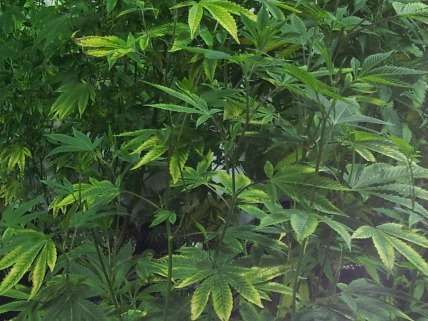Where Voters Are Likeliest to Legalize Marijuana in a Month
With pot on the ballot in nine states, support for allowing recreational use is strongest in California, while Florida looks likeliest to permit medical use.

A month away from Election Day, it seems likely that California will join the four other states that have legalized marijuana for recreational use. Every poll taken so far this year indicates that most voters favor Proposition 64, a.k.a. the Control, Tax, and Regulate Adult Use of Marijuana Act, with support in three September surveys ranging from 52 percent to 60 percent. If the California initiative passes, it will more than triple the number of Americans who live in jurisdictions that see fit to tolerate cannabis consumption without a doctor's note. Legalization also looks more likely than not in Maine and Nevada, although the numbers there are closer. Massachusetts and Arizona are longer shots.
In addition to the five states considering legalization for general use, four states will decide whether patients should be allowed to use (or, in Montana's case, have easier access to) marijuana for symptom relief. If the Arkansas, Florida, and North Dakota initiatives pass, the number of medical marijuana states will rise from 25 to 28. Polling indicates that support is strongest in Florida, where a similar measure fell two points short of the required 60 percent supermajority two years ago.
Here is a rundown of the nine marijuana initiatives on state ballots next month, including relevant polling data where available:
Arizona (Proposition 205): Legalizes marijuana for recreational use, allows home cultivation and sharing, and authorizes production and distribution by state-licensed businesses, some of which eventually could allow on-site consumption. Full text. Support for the measure in three polls conducted this year—one in April and two in August—averages 44 percent. Opposition averages 47 percent, with 9 percent undecided.
Arkansas (Issue 6 and Issue 7): Both initiatives allow production and distribution of marijuana for medical use. Issue 7 (full text) is more permissive than Issue 6 (full text), recognizing more treatable conditions (56 vs. 17) and allowing patients to grow their own medicine. A June survey by Public Opinion Strategies put support for Issue 6 and Issue 7 at 63 percent and 68 percent, respectively. A September survey by Talk Business & Politics/Hendrix College, by contrast, found that Issue 6 had more support: 49 percent, compared to 36 percent for Issue 7. Opposition was 43 percent and 53 percent, respectively. The last medical marijuana initiative in Arkansas fell a point and a half short in 2012.
California (Proposition 64): Legalizes marijuana for recreational use, allows home cultivation and sharing, authorizes production and distribution by state-licensed businesses, which can make deliveries to consumers and allow on-site consumption if licensed for that purpose. Full text. Support for the measure in eight polls conducted this year, including three from last month, averages 60 percent. Opposition averages 35 percent, with 5 percent undecided.
Florida (Amendment 2): Allows the use of marijuana for the treatment of 10 specified conditions as well as "other debilitating medical conditions of the same kind or class as or comparable to those enumerated." Authorizes production and distribution by state-licensed medical marijuana treatment centers. Full text. As a constitutional amendment, the initiative needs approval from 60 percent of voters to pass. Support for the measure in 10 polls conducted this year, including two last month, averages 69 percent. Opposition averages 24 percent, with 7 percent undecided.
Maine (Question 1): Legalizes marijuana for recreational use, allows home cultivation and sharing, and authorizes production and distribution by state-licensed businesses, which can allow on-site consumption with a special license. Full text. Support for the measure in two polls conducted this year—one on March and one in September—averages 53 percent. Opposition averages 40 percent, with 7 percent undecided.
Massachusetts (Question 4): Legalizes marijuana for recreational use, allows home cultivation and sharing, and authorizes production and distribution by state-licensed businesses, which can allow on-site consumption with local approval. Full text. Support for the measure in seven polls conducted this year, including two last month, averages 50 percent. Opposition averages 42 percent, with 8 percent undecided.
Montana (I-182): Allows production and distribution of marijuana by state-licensed providers for treatment of specified medical conditions and others subsequently added by the legislature. Full text. Although medical use has been legal in Montana since 2004, patients' access to marijuana is severely limited due to a 2011 legislative crackdown. I could not find any polling numbers for I-182, but the 2004 initiative passed with 62 percent of the vote.
Nevada (Question 2): Legalizes marijuana for recreational use, allows home cultivation and sharing, and authorizes production and distribution by state-licensed businesses, which cannot allow on-site consumption without new state legislation and local approval. Full text. Support for the measure in five polls conducted this year, including three last month, averages 51 percent. Opposition averages 40 percent, with 9 percent undecided.
North Dakota (Initiated Statutory Measure 5): Allows the use of marijuana for treatment of specified "debilitating medical conditions" and others added by the legislature. Authorizes production and distribution of medical marijuana by state-registered, nonprofit "compassion centers." Full text. In a 2014 poll of likely voters by the University of North Dakota College of Business and Public Administration, 47 percent said marijuana should be legal for medical use, 41 percent said it shouldn't, and 9 percent were neutral. I did not find any polls that asked specifically about the 2016 initiative.


Show Comments (20)